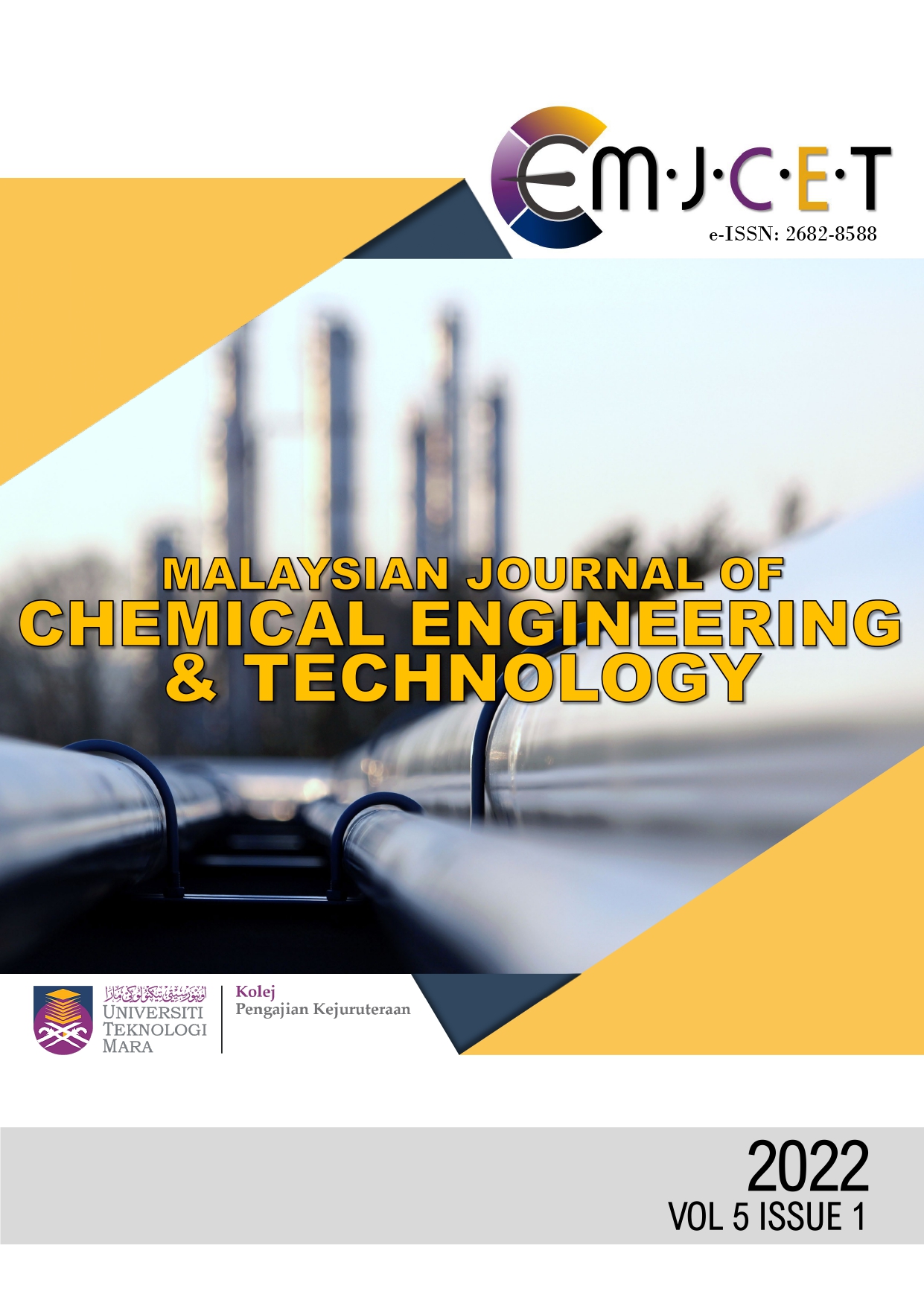Growth kinetic of Rhizopus sp. immobilised on loofah sponge for whole-cell biocatalyst in different cultivation media
DOI:
https://doi.org/10.24191/mjcet.v5i1.17242Keywords:
Fermentation, Immobilisation, Loofa sponge, Rhizopus, Whole-cell biocatalyst, Biomass support particlesAbstract
Immobilisation of filamentous fungi such as Rhizopus sp. onto biomass support particles (BSP) surface was studied as whole-cell biocatalyst. The function was to aid fermentation process. By using the microbial immobilisation process, the complex procedures of isolation, purification and immobilisation of extracellular enzyme can be avoided. Loofa sponge was selected as the BSP to aid in the immobilisation of the cells. In this study, the growth of immobilised Rhizopus sp. on loofa sponge was compared in four different cultivation media and the attachment of Rhizopus sp. on loofa sponge was investigated using scanning electron microscopy (SEM). The media used in this study were hydrolysed cassava starch, cassava dextrose, potato dextrose, and soy dextrose. The process condition and other parameters which were temperature, pH, inoculum dilution, and weight of loofa sponge, fixed at 30 °C, 7, 20 mL, and 2 g, respectively. The highest and lowest of maximum growth (ymax) of the immobilised cells were determined from potato dextrose and soy powder mixed with dextrose media, respectively at 1.5281 g/g and 1.0370 g/g. Whilst, the highest and lowest observed rate constant (k) were obtained from cassava starch mixed with dextrose and soy powder mixed with dextrose, which respectively at 2.9403 day−1 and −0.8763 day−1. SEM images showed the presence of mycelia attached to the loofah sponge after immobilisation process. In conclusion, Rhizopus sp. has been successfully immobilised on loofah sponge as a whole-cell biocatalyst.
References
Alasali, U., Azmi, A. S., Karaman, I., Alam, M. Z., & Mohamad Puad, N. I. (2022). Response surface optimization of Rhizopus sp. fungi immobilization onto loofah sponge using potato dextrose. Current Applied Science and Technology, 22(6), 1–16. https://li01.tci-thaijo.org/index.php/cast/article/view/252685
Azmi, A. S., Yusuf, N., Jimat, D. N., & Puad, N. I. M. (2016). Co-production of lactic acid and ethanol using Rhizopus sp. from hydrolyzed inedible cassava starch and leaves. IIUM Engineering Journal, 17(2), 1–10. https://doi.org/10.31436/iiumej.v17i2.610
Benabda, O., M’Hir, S., Kasmi, M., Mnif, W., & Hamdi, M. (2019). Optimization of Protease and Amylase production by Rhizopus Oryzae cultivated on bread waste using solid-state fermentation. Journal of Chemistry, 2019. 3738181. https://doi.org/10.1155/2019/3738181
Cabulis, U., Kirpluks, M., Stirna, U., Lopez, M. J., del Carmen Vargas-Garcia, M., Suárez-Estrella, F., & Moreno, J. (2012). Rigid polyurethane foams obtained from tall oil and filled with natural fibers: Application as a support for immobilization of lignin-degrading microorganisms. Journal of Cellular Plastics, 48(6), 500–515. https://doi.org/10.1177/0021955X12443142
He, Q., Shi, H., Gu, H., Naka, G., Ding, H., Li, X., Zhang, Y., Hu, B., & Wang, F. (2016). Immobilization of Rhizopus oryzae LY6 onto loofah sponge as a whole-cell biocatalyst for biodiesel production. BioResources, 11(1), 850–860. https://doi.org10.15376/biores.11.1.850-860
Huang, S., Xue, Y., Yu, B., Wang, L., Zhou, C., & Ma, Y. (2021). A review of the recent developments in the bioproduction of polylactic acid and its precursors optically pure lactic acids. Molecules, 26(21), 6446. https://doi.org/10.3390/molecules26216446
Karlström, A., Calle, F., Salazar, S., Morante, N., Dufour, D., & Ceballos, H. (2016). Biological implications in cassava for the production of amylose-free starch: Impact on root yield and related traits. Frontiers in Plant Science, 7, 604. https://doi.org/ 10.3389/fpls.2016.00604
López-Fernández, J., Benaiges, M. D., & Valero, F. (2020). Rhizopus Oryzae lipase, A promising industrial enzyme: biochemical characteristics, production and biocatalytic applications. Catalysts 2020, 10(1277), 1277. https://doi.org/10.3390/catal10111277
Maslova, O., Stepanov, N., Senko, O., & Efremenko, E. (2019). Production of various organic acids from different renewable sources by immobilized cells in the regimes of separate hydrolysis and fermentation (SHF) and simultaneous saccharification and fermentation (SFF). Bioresource Technology, 272, 1–9. https://doi.org/10.1016/j.biortech.2018.09.143
Melissa Petruzzello. (2016). Rhizopus (fungus genus). Britanica. https://www.britannica.com/science/Rhizopus/additional-info#history
Miller, C., Fosmer, A., Rush, B., McMullin, T., Beacom, D., & Suominen, P. (2011). Industrial production of lactic acid. In M., Moo-Young (Ed.), Comprehensive Biotechnology (2nd ed.) (pp. 179–188). Academic Press. https://doi.org/10.1016/B978-0-08-088504-9.00177-X
Polakovič, M., Švitel, J., Bučko, M., Filip, J., Neděla, V., Ansorge-Schumacher, M. B., & Gemeiner, P. (2017). Progress in biocatalysis with immobilized viable whole cells: systems development, reaction engineering and applications. Biotechnology Letters, 39(5),[Text Wrapping Break]667–683. https://doi.org/10.1007/s10529-017-2300-y
Ranjit, C., & Srividya, S. (2016). Lactic acid production from free and polyurethane immobilized cells of Rhizopus Oryzae MTCC 8784 by direct hydrolysis of starch and agro-industrial waste. International Food Research Journal, 23(6), 2646–2652.
Robertson, T. M., Alzaabi, A. Z., Robertson, M. D., & Fielding, B. A. (2018). Starchy carbohydrates in a healthy diet: The role of the humble potato. Nutrients, 10(11), 1764. https://doi.org/10.3390/nu10111764
Sattari, S., Vahabzadeh, F., & Aghtaei, H. K. (2015). Performance of loofa-immobilized Rhizopus Oryzae in the enzymatic production of biodiesel with use of oleic acid in n-hexane medium. Brazilian Journal of Chemical Engineering, 32(2), 367–376. https://doi.org/10.1590/0104-6632.20150322S00003525
Stevenson, D. G., Doorenbos, R. K., Jane, J., & Inglett, G. E. (2006). Structures and functional properties of starch from seeds of three soybean (Glycine max (L.) Merr.) varieties. Starch‐Stärke, 58(10), 509–519. [Text Wrapping Break]https://doi.org/ 10.1002/STAR.200600534
Downloads
Published
How to Cite
Issue
Section
License

This work is licensed under a Creative Commons Attribution-ShareAlike 4.0 International License.










